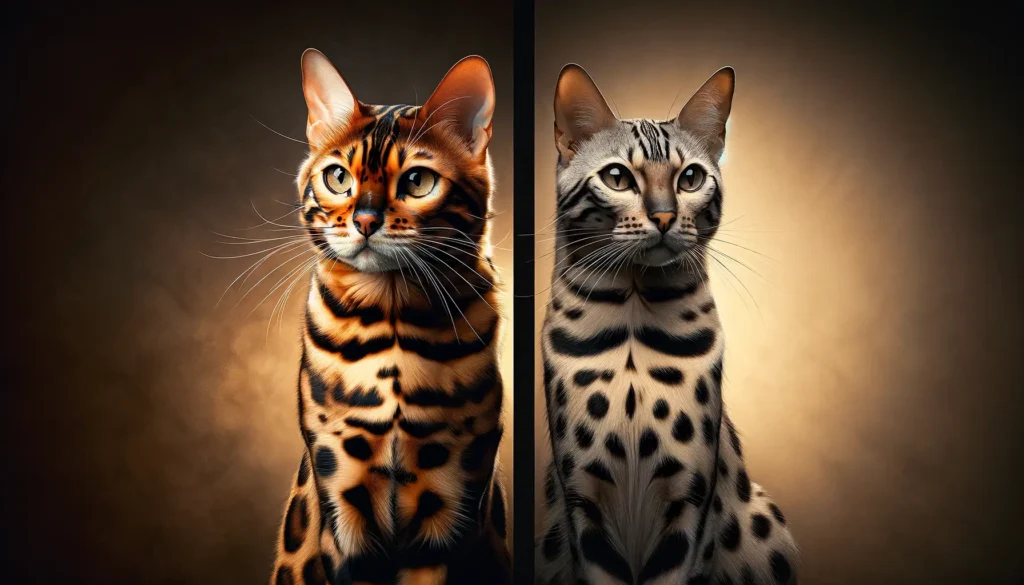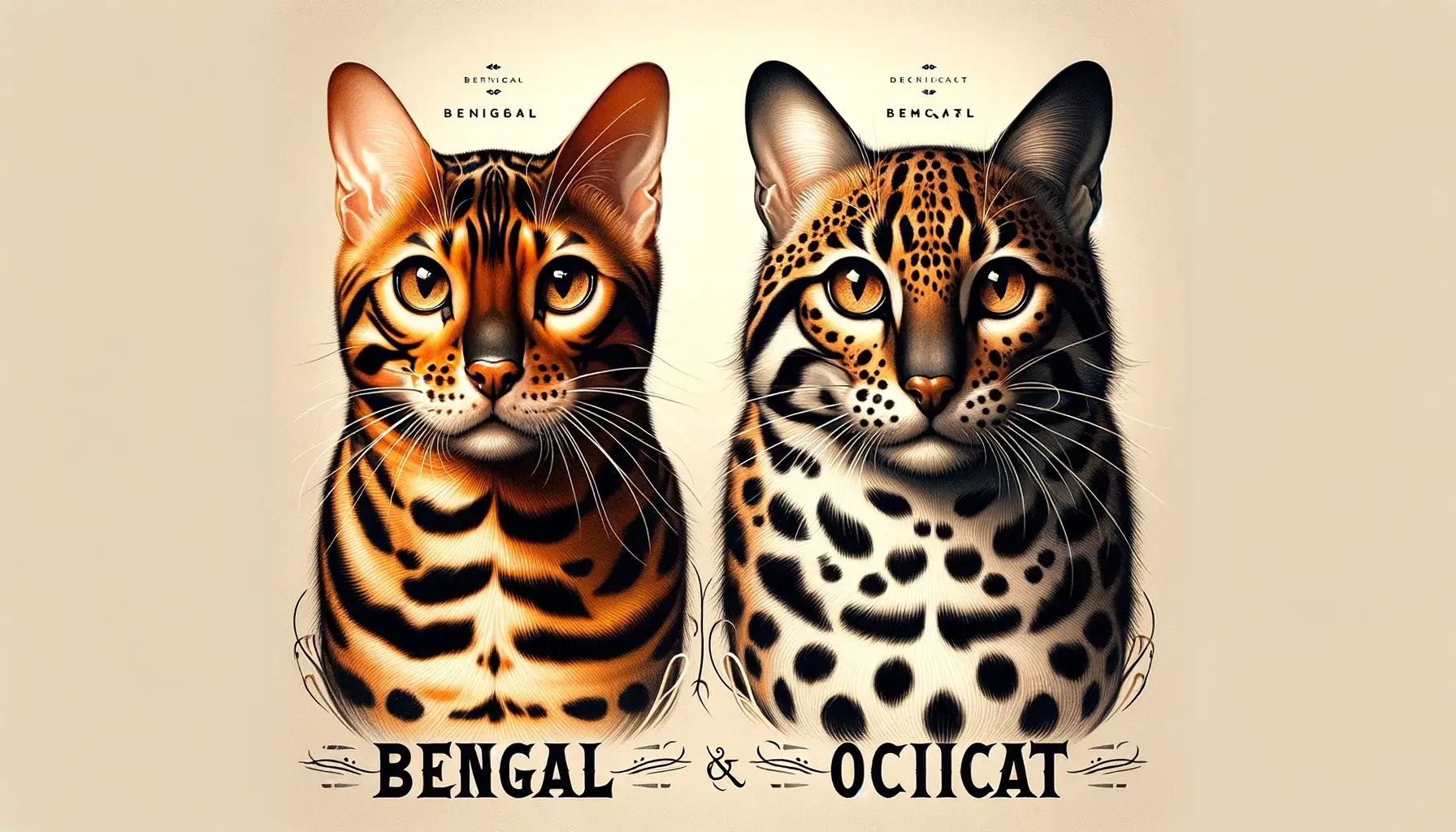In this section, we will introduce the Bengal cat vs Ocicat, two distinct cat breeds with unique characteristics. We will explore their differences in terms of size, sound, and overall traits, helping you understand how they stand apart from each other.
Bengal Cat: A Hybrid Beauty
The Bengal cat is a stunning and captivating feline breed, known for its exotic appearance and wild-like characteristics. This unique breed is a hybrid of the domestic cat and the Asian Leopard Cat, resulting in a beautiful blend of domestic and wild traits.
Bengals have a distinctive spotted coat that resembles that of their Asian Leopard Cat ancestors. These spots can come in a variety of colors and patterns, such as rosettes, marbled, and spotted coats. The Bengal’s coat is not only eye-catching but also soft and luxurious to the touch.
Aside from their striking appearance, Bengal cats are cherished for their affectionate and playful nature. They are known to be highly active cats, always ready for a game or adventure. Whether it’s chasing toys, climbing tall cat trees, or engaging in interactive play, Bengal cats are sure to keep you entertained.
Bengals are also highly intelligent and easy to train, making them suitable for families and individuals looking for a cat that can quickly learn tricks and commands. They are curious and love to explore their surroundings, so providing them with ample mental and physical stimulation is essential for their well-being.
When it comes to grooming, Bengal cats are relatively low-maintenance. They have a short, dense coat that requires weekly brushing to keep it healthy and free from matting. Regular nail trims and dental check-ups are also essential for their overall health.
Like any breed, Bengal cats may be prone to certain health conditions. Hypertrophic Cardiomyopathy (HCM), a heart disease, is relatively common in Bengal cats. Regular veterinary check-ups and screening for HCM can help maintain their cardiovascular health. Progressive Retinal Atrophy (PRA), a degenerative eye disease, is another concern in Bengals. Breeders often screen their cats for PRA to ensure the overall health of the breed.
If you’re a cat lover looking for a unique and active companion, the Bengal cat may be the perfect choice for you. Their exotic appearance, playful temperament, and affectionate nature make them a truly remarkable addition to any home.
Ocicat: The Energetic Companion
In this section, we will explore the Ocicat breed. You will learn about their origins, including the work of breeder Jean Mill, and discover their lively and affectionate nature. We will discuss their coat patterns, colors, and physical characteristics, as well as their sociability with humans and other pets. If you are looking for an energetic and playful companion, the Ocicat may be the perfect choice for you.
The History of Ocicats
The Ocicat breed is relatively new but has gained popularity for its resemblance to wild cats. They were first developed in the 1960s by Jean Mill, who crossed Abyssinian, Siamese, and American Shorthair cats to create this unique breed. The International Cat Association recognized Ocicats as a breed in 1966, and they quickly became a favorite among cat enthusiasts.
Coat Patterns and Colors
Ocicats have short, smooth coats with a tabby pattern. Their coat color can range from tawny, chocolate, cinnamon, or blue, and they often have spots throughout their body. These spots give them a leopard-like appearance, adding to their exotic charm.
Playful and Affectionate Nature
Ocicats are known for their lively and affectionate personalities. They enjoy playing and are great companions for both individuals and families. These cats love to climb and explore their surroundings, so providing them with a cat tree or other vertical spaces will keep them mentally and physically stimulated.
Social with Humans and Other Pets
Ocicats are social cats that are generally good with children, other cats, and even dogs. They form strong bonds with their human companions and seek their attention and affection. If you are looking for a cat that will be a part of your everyday life and enjoy interacting with you, an Ocicat may be the perfect choice.
Comparing Bengal Cat vs Ocicats
| Feature | Bengal Cats | Ocicats |
|---|---|---|
| Origin | Asian Leopard Cat hybrid | Abyssinian, Siamese, American Shorthair mix |
| Coat Patterns | Spotted rosettes or marbled | Tabby with spots |
| Temperament | Active, adventurous, affectionate | Playful, social, affectionate |
| Size | Medium to large | Medium |
| Grooming | Low maintenance, weekly brushing | Low maintenance, occasional brushing |
| Sociability | Social with humans and other pets | Social with humans and other pets |

Bengal cat vs ocicat cat
Comparing Bengal Cats and Ocicats
In this section, we will directly compare Bengal cats and Ocicats, highlighting their similarities and differences. We will discuss their temperament, size, coat patterns, and other distinguishing features. You will gain a better understanding of these two breeds and be able to make an informed decision when choosing between them.
Temperament
Bengal cats and Ocicats are both known for their intelligent and highly active nature. However, there are some differences in their temperaments. Bengal cats are typically more independent and may exhibit some wild behaviors. On the other hand, Ocicats are highly social and crave human attention. They are often described as affectionate and enjoy cuddling on their owner’s lap.
Size
When it comes to size, Bengal cats are generally larger and more muscular compared to Ocicats. Bengal cats can reach a weight of 8 to 15 pounds, while Ocicats typically weigh between 6 to 14 pounds. However, it’s important to note that individual cat sizes may vary.
Coat Patterns
Both Bengal cats and Ocicats have unique coat patterns that resemble their wild appearance. Bengal cats feature striking rosettes or marbled patterns, often resembling that of a leopard or ocelot. Ocicats, on the other hand, have a distinctly spotted coat pattern, similar to that of a wild jungle cat.
Other Distinguishing Features
While Bengal cats and Ocicats share some similarities in their appearance and temperament, there are a few other distinguishing features. The Ocicat breed was born from a combination of Abyssinian, Siamese, and American Shorthair cats, resulting in their unique hybrid heritage. Bengal cats, on the other hand, have Asian Leopard Cats in their ancestry, giving them a more exotic and wild appearance.
Additionally, it’s worth noting that Ocicats are generally a healthy breed with no known breed-specific health issues. Bengal cats, on the other hand, may be prone to certain health conditions such as hypertrophic cardiomyopathy and progressive retinal atrophy.
| Feature | Bengal Cats | Ocicats |
|---|---|---|
| Temperament | Independent, may exhibit wild behaviors | Social, affectionate, enjoys cuddling on owner’s lap |
| Size | Larger and more muscular (8-15 pounds) | Smaller (6-14 pounds) |
| Coat Patterns | Rosettes or marbled patterns resembling leopards | Distinct spotted pattern resembling wild jungle cats |
| Distinguishing Features | Hybrid breed with Asian Leopard Cat ancestry | Born from Abyssinian, Siamese, and American Shorthair cats |
| Potential Health Issues | Hypertrophic cardiomyopathy, progressive retinal atrophy | No known breed-specific health issues |

Bengal cat vs ocicat cat
Conclusion
In conclusion, both Bengal cats and Ocicats are captivating in their own right. While Bengal cats offer a wild and exotic appearance with their hybrid heritage, Ocicats impress with their energetic and affectionate nature. Whether you prefer the striking beauty of a Bengal cat or the playful companionship of an Ocicat, the choice ultimately depends on your personal preferences and lifestyle.
When deciding between the two breeds, it is essential to consider factors such as activity levels, grooming needs, and compatibility with other pets. Bengal cats are known for their active nature and love for human interaction, making them an excellent choice for families seeking an adventurous, engaging companion. On the other hand, if you’re looking for an energetic and affectionate cat that enjoys climbing and playing, the Ocicat may be the perfect fit for you.
Regardless of which breed you choose, both Bengal cats and Ocicats have unique qualities that make them wonderful companions for cat lovers. Whether you are enticed by the Bengal’s exotic appearance or charmed by the Ocicat’s playful and affectionate demeanor, both breeds can provide endless joy and companionship to enrich your life.
FAQs
Q: What are the main differences between Bengal cats and Ocicats?
A: Bengal cats have a wild appearance with their leopard-like spots, while Ocicats have a more domestic look with their spotted coat resembling that of a wild Ocelot.
Q: How do Bengal cats and Ocicats differ in size?
A: Bengals are typically larger than Ocicats, with a more muscular build and longer body.
Q: Which cat breed is more suitable for households with other pets?
A: Both Bengal cats and Ocicats can get along well with other pets, but it ultimately depends on the individual cat’s temperament and socialization.
Q: Are Bengal cats or Ocicats more prone to specific health issues?
A: Bengal cats are known to be susceptible to a condition called amyloidosis, while Ocicats are generally considered a healthy breed with no specific health concerns.
Q: Do Bengal and Ocicat kittens have different behavior traits?
A: Bengal kittens are known for their high energy levels and playful nature, while Ocicat kittens are typically outgoing and social from a young age.
Q: How did Ocicats and Bengals get their names?
A: Ocicats got their name from their resemblance to wild Ocelots, while Bengals were named after their Asian Leopard Cat ancestors.

Hey guys, My name is Simon Smith. I’m from Canada and live near Victoria
I live with my sweet family and have 20+ Ragdolls of different types. I love them as my own children. My profession is as a hotel manager.
I love to keep Ragdolls and grow their breeder case. I have 7 years of experience.
I’m an expert in cat care. So, I’m here to provide you with new information about my cats daily. This is my personal blog website, so I request that you kindly visit our site daily.
If you’re a Ragdolls lover and you have any questions or confusion about cats, text me on the Contact Us page or Gmail.
Thank u
